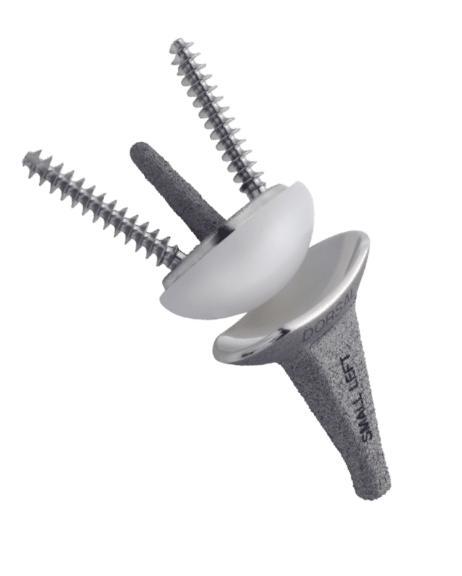What is wrist arthroplasty?
Wrist arthroplasty
Orthopaedic surgeons perform wrist replacement, called wrist arthroplasty, as an effective treatment for severe pain and weakness in the wrist. During surgery, the surgeon replaces diseased and injured joint components with medical-grade implants designed to appear similar to a normal, healthy wrist joint. To qualify for wrist replacement, the important soft tissue must be functioning well to support this procedure. Stryker offers the tools for a different approach for when the soft tissue is not healthy enough to support a replacement.
Stryker designed the three-piece total joint replacement as a surface replacement implant, requiring minimal bone removal. The surgeon inserts the implant through the dorsal, or back of the hand, avoiding the very important soft tissue structures on the palm side of the hand. Worldwide, surgeons have successfully implanted many wrist replacements, like the ReMotion, with reports showing positive results sustained as long as 8-10 years.1
More detail? Wrist surgery was first performed in the late 1800s. Since that time, many different implants and materials have been used to treat very severe wrist arthritis. The ReMotion total wrist implant is designed to be stable and resist dislocation due to its deep radial cup design. Mid- and long-term studies have shown that wrist replacement surgery may offer improved range of motion, less pain while resting and during activities, and improved grip strength.1,2

References:
- Herzberg G, et al. “Remotion” total wrist arthroplasty: Preliminary results of a prospective international multi center study of 215 cases. J Wrist Surg. 2012;1:17-22.
- Sagerfors M, Gupta A, Brus O, Peterson K. Total wrist arthroplasty: A single center study of 219 cases with 5 year follow-up.” J Hand Surg Am. 2015;40(12):2380-2387
VariAx 2 Wrist Fusion System
Indications: The Stryker VariAx 2 Wrist Fusion System is indicated for wrist arthrodesis and fixation of fractures in patients with wrist arthritis or fractures of other small bones of the carpus. Specific indications include: Post-traumatic arthritis of the joints of the wrist, Rheumatoid wrist deformities requiring restoration, Complex carpal instability, Post-septic arthritis of the wrist, Severe unremitting wrist pain related to motion, Brachial plexus nerve palsies, Tumor resection, Spastic deformities, Contra-Indications: The physician’s education, training and professional judgment must be relied upon to choose the most appropriate device and treatment.
For all warnings and precautions please refer to the appropriate labeling.
Conditions presenting an increased risk of failure include: Any active or suspected latent infection or marked local inflammation in or about the affected area, Compromised vascularity that would inhibit adequate blood supply to the fracture or the operative site, Bone stock compromised by disease, infection or prior implantation that can not provide adequate support and/or fixation of the devices, Material sensitivity, documented or suspected, Obesity. An overweight or obese patient can produce loads on the implant that can lead to failure of the fixation of the device or to failure of the device itself, Patients having inadequate tissue coverage over the operative site, Implant utilization that would interfere with anatomical structures or physiological performance, Any mental or neuromuscular disorder which would create an unacceptable risk of fixation failure or complications in postoperative care, Other medical or surgical conditions which would preclude the potential benefit of surgery
Source: VAX-ST-23
ReMotion Total Wrist System
Indications: The ReMotion Total Wrist System is intended for replacement of the painful wrist joint due to rheumatoid arthritis, osteo-arthritis, or post-traumatic arthritis.
Contraindications: Bone, musculature, tendons, or adjacent soft tissue compromised by disease, infection, or prior implantation, which cannot provide adequate support or fixation for the prosthesis.
Known sensitivity to materials used in this device. Skeletal Immaturity
Source: V15114
The information presented is for educational purposes only. Stryker is not dispensing medical advice. Please speak to your doctor to decide which type of surgery is right for you. Only your doctor can make the medical judgment which products and treatments are right for your own individual condition. As with any surgery, joint replacement surgery carries certain risks. Your surgeon will explain all the possible complications of the surgery, as well as side effects. Additionally, the lifetime of a joint replacement product is not infinite and varies with each individual. Also, each patient will experience a different post-operative activity level, depending on their own individual clinical factors. Your doctor will help counsel you about how to best maintain your activities in order to potentially prolong the lifetime of the device.
Stryker Corporation or its divisions or other corporate affiliated entities own, use or have applied for the following trademarks or service marks: ReMotion, Stryker, T2, Together with our customers, we are driven to make healthcare better, VariAx. All other trademarks are trademarks of their respective owners or holders.
REM-AWI-1_Rev-1, 01-2019
Please upgrade your internet browser.
Our website was designed for a range of browsers. However, if you would like to use many of our latest and greatest features, please upgrade to a modern, fully supported browser.
Find the latest versions of modern supported browsers »Note: If you are browsing in Internet Explorer 9 or later, and you are still seeing this message, you may be in Compatability Mode. Look for the Compability View icon in your Address bar, or the Compatability View and Compatability View settings from the Tools Menu in your Internet Explorer toolbar (hit the ALT key if your menu bar is hidden). If you are on an Intranet, you may need to contact your IT Support about Compatability View settings and whitelists.